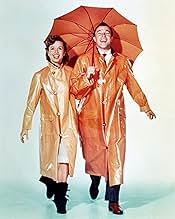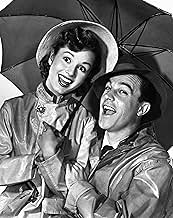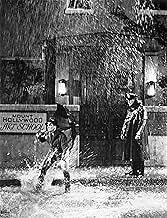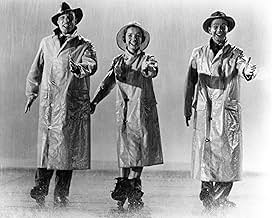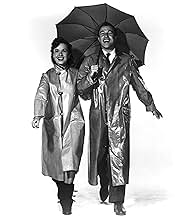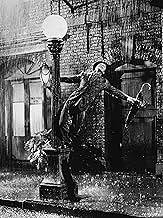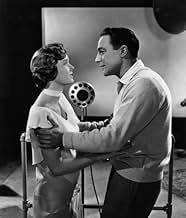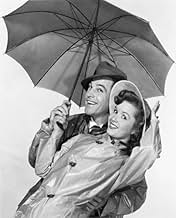Uma produtora de cinema mudo e seu elenco enfrentam uma transição difícil para o cinema falado.Uma produtora de cinema mudo e seu elenco enfrentam uma transição difícil para o cinema falado.Uma produtora de cinema mudo e seu elenco enfrentam uma transição difícil para o cinema falado.
- Indicado a 2 Oscars
- 8 vitórias e 9 indicações no total
Dawn Addams
- Teresa - a Lady-in-Waiting
- (não creditado)
John Albright
- Call Boy
- (não creditado)
Shirlee Allard
- Chorus Girl
- (não creditado)
Bebe Allen
- Chorus Girl
- (não creditado)
Sue Allen
- Chorus Girl
- (não creditado)
John Angelo
- Dancer
- (não creditado)
Marie Ardell
- Chorus Girl
- (não creditado)
Bette Arlen
- 'Miss January' in 'Beautiful Girl' segment
- (não creditado)
David Bair
- Chorus Boy
- (não creditado)
Jane Bateman
- Chorus Girl
- (não creditado)
- Direção
- Roteiristas
- Elenco e equipe completos
- Produção, bilheteria e muito mais no IMDbPro
Enredo
Você sabia?
- CuriosidadesFor the "Make 'em Laugh" number, Donald O'Connor revived a trick he had done as a young dancer: running up a wall and completing a somersault. The number was so physically taxing that O'Connor ended up in a hospital bed for a week after its completion. He suffered from exhaustion and carpet burns. After an accident ruined all of the initial footage, O'Connor agreed to do the difficult number all over again.
- Erros de gravaçãoDuring the Cyd Charisse nightclub dance number, when she's wrapped around Gene Kelly, her body completely changes position between frames due to a clumsy edit. According to commentary on the special edition DVD, this cut of only a few frames' duration dates back to the original release of the film and no one knows why it exists.
- Citações
Cosmo Brown: Lina. She can't act, she can't sing, she can't dance. A triple threat.
- ConexõesEdited from Os Três Mosqueteiros (1948)
- Trilhas sonorasFit as a Fiddle
(1932)
Music by Al Hoffman (uncredited) and Al Goodhart (uncredited)
Lyrics by Arthur Freed
Originally from the 1932 stage revue "George White's Music Hall Varieties"
Sung by Gene Kelly (uncredited) and Donald O'Connor (uncredited)
Avaliação em destaque
Don Lockwood (Gene Kelly) and Lina Lamont (Jean Hagen) are a famed Hollywood duo, making films at the tail end of the silent era. The studio has been issuing PR suggesting that they're a romantic item. In reality, they can barely stand one another. One night, while on the town with his best friend Cosmo Brown (Donald O' Connor), Lockwood has to run to escape fans who want a piece of him badly enough that they'll literally rip his clothes to shreds. He hops over a number of moving vehicles and ends up in the passenger seat of Kathy Selden's (Debbie Reynolds) car. Lockwood seems immediately taken with her, but she gives him the cold shoulder. She says she's an actress with a love of theater, and she looks down on film acting. Later, Lockwood discovers that she was inflating the truth a bit, as he sees Selden performing as a cute song & dance girl at an industry party he's attending. She runs out of the party and Lockwood chases after her, but he's too late. While he tries to track her down, he, Lamont and their studio have to deal with the changing nature of film in 1927--made much more difficult by the fact that Lamont may look glamorous, but she talks more like Fran Drescher in "The Nanny" (1993).
Aside from the more serious aspects of the plot, Singing in the Rain is a great success as a romance and a musical. It also has an astoundingly rich Technicolor look, and it is charmingly humorous. Kelly and Reynolds click on screen, even if offscreen Kelly, who also co-directed and co-choreographed, was famously difficult to work with--he drove Reynolds so hard (she was a much more inexperienced dancer) that her feet literally started bleeding at one point. The songs are great, they're worked into the story well--which is perhaps surprising given that most of them weren't written specifically for this film--and the choreography is impeccable, frequently jaw dropping and always aesthetically wondrous and sublime. If for nothing else, the film is worth a look for its often-athletic dance numbers, which can resemble Jackie Chan's showy martial arts stunts as much as dancing. It's also imperative viewing for cultural literacy in the realm of film.
But the more serious aspects of the plot are fascinating as well. In a significant way, Singing in the Rain is about film technology. Film technology is the hinge of the plot, after all. The climax and dénouement are decided by the advent of synchronized sound in the film industry. We see studio head R.F. Simpson (Millard Mitchell) demonstrating sound films at the party where Lockwood sees Selden for the second time, providing two big turning points at once. There are sequences of actors heading off to diction coaches, as happened in reality once sound entered the scene, and also in reality as in the film some actor's careers were jeopardized by having to suddenly master a new skill.
But Singing in the Rain is about technology on another level, too. Kelly and co-director Stanley Donen go to great lengths to ensure that the film is an exemplar of state-of-the-art film technology in 1952. For example, the beautiful Technicolor cinematography is emphasized by the fabulously colorful costumes and production design--they're showing off cutting edge color. The sound is as good as it could be in 1952, and the fact that this is a musical helps show that off. The sets and effects are complex and an attempt is made to show them off as well.
Donen and Kelly often play up the artificiality of the sets and effects to emphasize artistry and technology. This is clearly shown in the "Make 'Em Laugh" sequence (and surrounding events) and the extended "Broadway Rhythm Ballet" sequence with Cyd Charisse. Showing off this artistry and technology also occurs very subtly, as with the rain in the "Singing in the Rain" sequence. Even today, rain machines are frequently employed in a way that it appears to be raining on film, but in reality, it's just enough coverage to produce the illusion. In the "Singing in the Rain" sequence, they make sure that you can see the whole area is getting flooded, and they use Gene Kelly's umbrella, as torrents of water bounce off of it, to emphasize that no matter where he goes, "rain" is pouring down on him.
While there are many musicals I like as much as Singing in The Rain, this is one of the better-loved examples of that genre, and for good reason. Any musical lover has surely seen this already, and if not, they should run out now and pick it up on DVD. If you're relatively unfamiliar with classic Hollywood musicals, this is one of the best places to start.
Aside from the more serious aspects of the plot, Singing in the Rain is a great success as a romance and a musical. It also has an astoundingly rich Technicolor look, and it is charmingly humorous. Kelly and Reynolds click on screen, even if offscreen Kelly, who also co-directed and co-choreographed, was famously difficult to work with--he drove Reynolds so hard (she was a much more inexperienced dancer) that her feet literally started bleeding at one point. The songs are great, they're worked into the story well--which is perhaps surprising given that most of them weren't written specifically for this film--and the choreography is impeccable, frequently jaw dropping and always aesthetically wondrous and sublime. If for nothing else, the film is worth a look for its often-athletic dance numbers, which can resemble Jackie Chan's showy martial arts stunts as much as dancing. It's also imperative viewing for cultural literacy in the realm of film.
But the more serious aspects of the plot are fascinating as well. In a significant way, Singing in the Rain is about film technology. Film technology is the hinge of the plot, after all. The climax and dénouement are decided by the advent of synchronized sound in the film industry. We see studio head R.F. Simpson (Millard Mitchell) demonstrating sound films at the party where Lockwood sees Selden for the second time, providing two big turning points at once. There are sequences of actors heading off to diction coaches, as happened in reality once sound entered the scene, and also in reality as in the film some actor's careers were jeopardized by having to suddenly master a new skill.
But Singing in the Rain is about technology on another level, too. Kelly and co-director Stanley Donen go to great lengths to ensure that the film is an exemplar of state-of-the-art film technology in 1952. For example, the beautiful Technicolor cinematography is emphasized by the fabulously colorful costumes and production design--they're showing off cutting edge color. The sound is as good as it could be in 1952, and the fact that this is a musical helps show that off. The sets and effects are complex and an attempt is made to show them off as well.
Donen and Kelly often play up the artificiality of the sets and effects to emphasize artistry and technology. This is clearly shown in the "Make 'Em Laugh" sequence (and surrounding events) and the extended "Broadway Rhythm Ballet" sequence with Cyd Charisse. Showing off this artistry and technology also occurs very subtly, as with the rain in the "Singing in the Rain" sequence. Even today, rain machines are frequently employed in a way that it appears to be raining on film, but in reality, it's just enough coverage to produce the illusion. In the "Singing in the Rain" sequence, they make sure that you can see the whole area is getting flooded, and they use Gene Kelly's umbrella, as torrents of water bounce off of it, to emphasize that no matter where he goes, "rain" is pouring down on him.
While there are many musicals I like as much as Singing in The Rain, this is one of the better-loved examples of that genre, and for good reason. Any musical lover has surely seen this already, and if not, they should run out now and pick it up on DVD. If you're relatively unfamiliar with classic Hollywood musicals, this is one of the best places to start.
- BrandtSponseller
- 30 de abr. de 2005
- Link permanente
Principais escolhas
Faça login para avaliar e ver a lista de recomendações personalizadas
Detalhes
- Data de lançamento
- País de origem
- Idioma
- Também conhecido como
- Cantando bajo la lluvia
- Locações de filme
- Metro-Goldwyn-Mayer Studios - 10202 W. Washington Blvd., Culver City, Califórnia, EUA(New York City Streets)
- Empresa de produção
- Consulte mais créditos da empresa na IMDbPro
Bilheteria
- Orçamento
- US$ 2.540.800 (estimativa)
- Faturamento bruto nos EUA e Canadá
- US$ 1.884.537
- Fim de semana de estreia nos EUA e Canadá
- US$ 13.643
- 10 de nov. de 2002
- Faturamento bruto mundial
- US$ 2.093.659
- Tempo de duração1 hora 43 minutos
- Cor
- Mixagem de som
- Proporção
- 1.37 : 1
Contribua para esta página
Sugerir uma alteração ou adicionar conteúdo ausente

Principal brecha
By what name was Cantando na Chuva (1952) officially released in India in Hindi?
Responda






